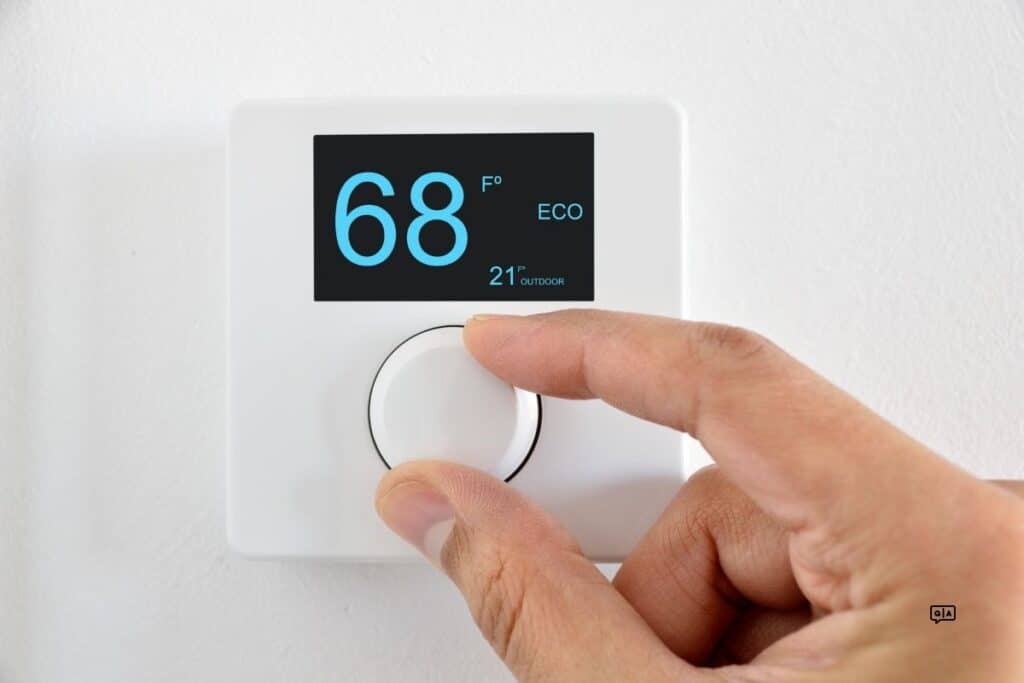Finding the perfect temperature for your home in the winter can make all the difference in your comfort!
It’s a good idea to set your thermostat to around 68–70°F when you’re up and about and then lower it a bit when you’re sleeping or away. The Department of Energy suggests this to help you stay cozy and energy-efficient. And if you’re curious about what’s considered healthy, the World Health Organization recommends keeping indoor temps between 64–75°F.
So, feel free to adjust based on what feels best for you!
Step-by-Step Process
Whether you have a manual, programmable, or smart thermostat, here’s a step-by-step guide on how to set your thermostat for winter.
1. Set Your Preferred Temperature
- For most homes, the ideal winter temperature is:
- 68°F (20°C) when awake and at home.
- Lower the temperature to 60–65°F (15–18°C) while sleeping or when you’re away.
- Adjust based on personal comfort, insulation quality, and the efficiency of your heating system.
2. Use Energy-Saving Temperature Settings
- According to the U.S. Department of Energy, lowering your thermostat by 7–10°F for at least 8 hours a day can save up to 10% annually on heating costs.
- If you’re comfortable, keep the thermostat lower when you’re inactive, such as during nighttime or work hours.

3. Program Your Thermostat (For Programmable Models)
- If your thermostat is programmable, set specific times for temperature adjustments:
- Morning (6–8 AM): Set to 68°F when you wake up.
- Daytime (8 AM–5 PM): Lower to 60–65°F if no one is home.
- Evening (5–10 PM): Raise to 68°F or your desired comfort level.
- Night (10 PM–6 AM): Lower to 60–65°F for sleeping.
4. Optimize a Smart Thermostat
- Smart thermostats like Nest or Ecobee can learn your habits and automatically adjust temperatures.
- Use features like geofencing to lower the temperature when you’re away and raise it when you return.
- Monitor energy usage through the thermostat app to fine-tune settings.
5. Use the Fan Setting Appropriately
- Set the fan to “Auto” rather than “On”:
- Auto: The fan runs only when the heating system is actively warming the home, conserving energy.
- On: The fan runs continuously, which can increase energy usage unnecessarily.
6. Adjust for Humidity Levels
- In winter, indoor air becomes dry, making lower temperatures feel colder. Use a humidifier to maintain humidity levels between 30–50%, making the air feel warmer and reducing the need to raise the thermostat.
7. Avoid Constant Adjustments
- Pick a comfortable base temperature and stick to it. Adjusting the thermostat can make your heating system work harder, reducing efficiency.
- Use scheduled programming or smart thermostat features to automate changes instead.
Ideal Temperature for Comfort and Savings
- Occupied Hours: 68°F is the most recommended setting for balancing comfort and energy efficiency.
- Unoccupied Hours: Lowering the temperature to 60–65°F when you’re not home helps reduce energy costs.
Frequent temperature changes can stress your heating system as it tries to reheat your home, leading to more wear and tear. Keeping your temperature steady—within just 5°F of your base setting—can help your system work more efficiently and last longer. It’s a simple way to keep your home cozy while caring for your heating system!
When to Raise the Temperature
- If you have elderly individuals, infants, or people with medical conditions in the home, consider setting the thermostat slightly higher, such as 70–72°F, to ensure their comfort and safety.
Additional Energy-Saving Strategies
- Seal Air Leaks: Drafty windows and doors can make your home feel colder, prompting higher thermostat settings. Use weatherstripping and caulking to seal leaks.
- Use a Ceiling Fan: Set ceiling fans to rotate clockwise at a low speed to push warm air down from the ceiling.
- Maximize Sunlight: Open curtains during the day to let in natural heat and close them at night to retain warmth.
Using the “AUTO” setting is a great way to boost your energy efficiency and keep your home comfy without wasting energy. If you have a programmable thermostat, take advantage of it! You can easily lower the temperature when you’re not at home. It’s a simple way to save energy and keep things cozy!
By following these steps, you can set your thermostat for winter to keep your home comfortable, reduce energy bills, and ensure your heating system operates efficiently throughout the season.






